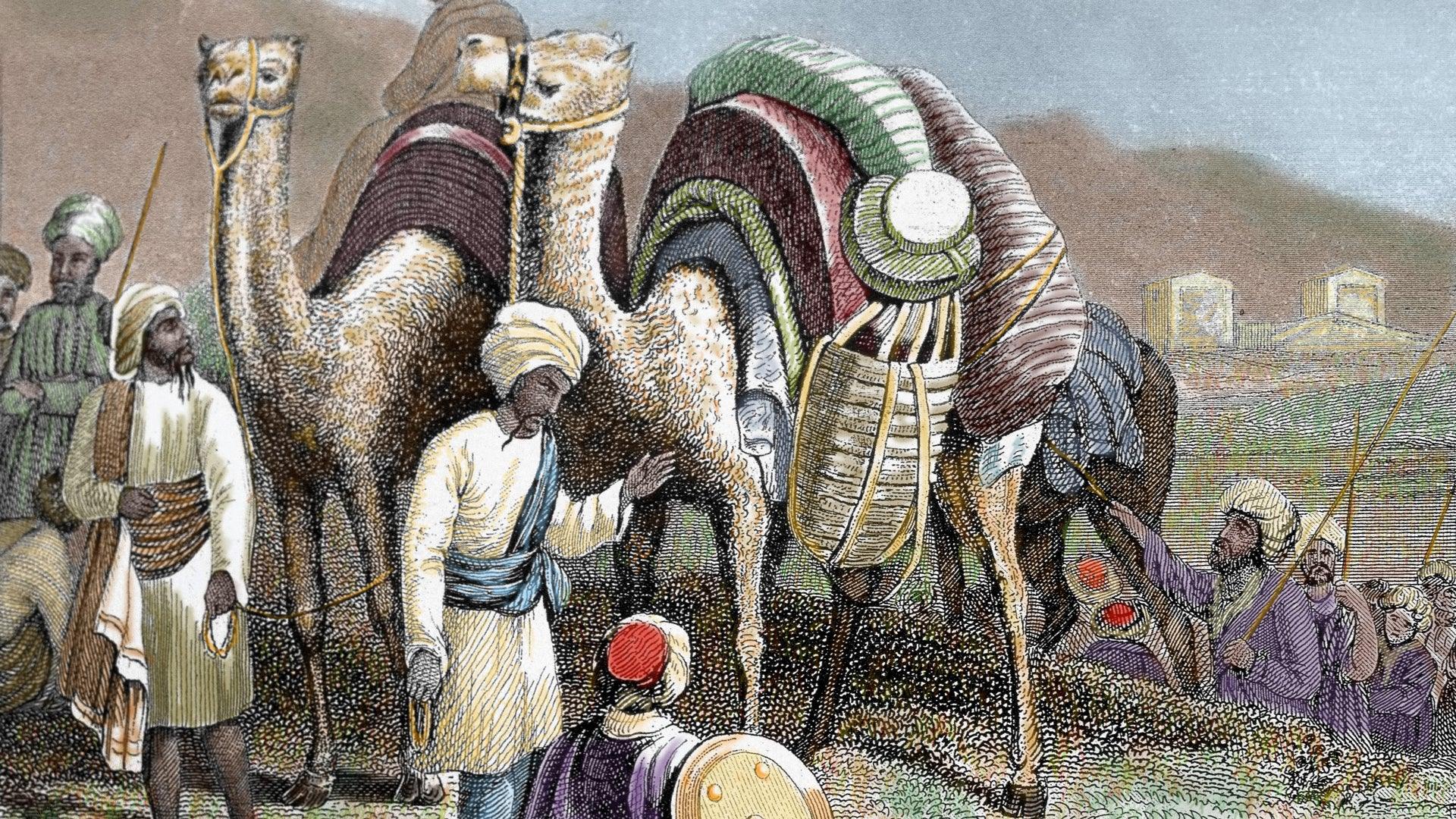
The Fascinating History of the Ancient Silk Road
The Silk Road, a term coined by German geographer Ferdinand von Richthofen in the 19th century, evokes images of bustling caravans, exotic goods, and the vibrant exchange of cultures across vast distances. It wasn’t a single road, but rather a complex network of interconnected trade routes spanning over 4,000 miles, linking the East and West for centuries. From the bustling markets of Chang’an to the vibrant cities of the Mediterranean, this ancient pathway profoundly shaped the course of human history, fostering economic prosperity, cultural diffusion, and the transmission of knowledge across continents. This exploration delves into the fascinating history of the Silk Road, from its humble beginnings to its enduring legacy in the modern world.
I. The Genesis of Exchange: Early Trade Routes and the Han Dynasty
The foundations of the Silk Road were laid not in a single grand design, but rather through a gradual process of expanding trade networks. While the precise origins are difficult to pinpoint definitively, the Han Dynasty (206 BCE – 220 CE) witnessed a significant expansion of Chinese influence and trade into Central Asia. This era marks a crucial turning point in the development of the Silk Road, driven by the ambition of the Han emperors to extend their reach and control access to valuable resources.
The legendary journey of Zhang Qian, a Chinese diplomat dispatched to the West in 139 BCE, exemplifies this ambitious policy. His mission, initially aimed at forging alliances against the Xiongnu nomadic tribes, unexpectedly opened up new avenues for trade and cultural exchange. Zhang Qian’s expeditions provided invaluable information about the lands to the west, including the Parthian Empire and the Indo-Greek kingdoms, fueling further exploration and the establishment of formal trade routes.
These initial trade routes were not uniformly paved highways; they were a patchwork of trails, caravan routes, and waterways, adapting to the varied terrain they traversed. The Silk Road weaved its way through treacherous mountain passes, vast deserts like the Taklamakan, and fertile river valleys. The lack of a unified political entity governing the entire route necessitated a complex system of alliances, treaties, and often, negotiations with various nomadic groups and powerful kingdoms along the way.
The primary commodities exchanged during the early stages of the Silk Road were silk, naturally, alongside other prized Chinese goods such as tea, porcelain, and lacquerware. In return, the East received horses (particularly prized warhorses from Central Asia), precious metals, glassware, textiles, and spices from the West. This exchange was not merely an economic transaction; it represented a crucial transfer of wealth and resources that underpinned the development and prosperity of the participating societies.
The Han Dynasty also saw the beginning of significant religious and cultural exchange. While not the primary driving force behind the Silk Road’s development, the transmission of ideas and religious beliefs along these routes would ultimately leave an indelible mark on the world. Buddhism, originating in India, gradually made its way eastward along the Silk Road, finding fertile ground in China and later spreading to Korea and Japan. This religious diffusion was facilitated by the travels of Buddhist monks who carried scriptures and religious artifacts across vast distances, profoundly influencing the spiritual and philosophical landscape of East Asia.
II. The Flourishing Tang Dynasty and its Golden Age of Exchange
The Tang Dynasty (618-907 CE) represents the zenith of the Silk Road’s influence and prosperity. A period of relative peace and stability within China allowed for unprecedented economic growth and expansion of trade networks. The capital city, Chang’an (modern-day Xi’an), blossomed into a cosmopolitan hub, a melting pot of cultures where merchants, scholars, and travelers from across the globe converged. The city’s impressive infrastructure, including extensive markets and well-maintained roads leading to the furthest reaches of the empire, facilitated the smooth flow of goods and people along the Silk Road.
During the Tang Dynasty, the volume of trade increased exponentially, with a wider variety of goods being exchanged. Chinese silk, renowned for its quality and beauty, continued to be a highly sought-after commodity. However, the range of goods extended far beyond silk, encompassing porcelain, jade, tea, gunpowder, and advanced printing technologies. In return, Central Asia, India, the Middle East, and even Europe contributed to the exchange with spices, horses, glassware, textiles, and precious metals, fostering a complex web of economic interdependence.
This era also witnessed an unprecedented flowering of cultural and religious exchange. Buddhism, already established in China, further flourished under Tang patronage. Nestorian Christianity, Islam, and Manichaeism also found their way along the Silk Road, enriching the religious tapestry of the region. The exchange of religious ideas, practices, and artistic expressions fostered a dynamic interplay of faith and culture that significantly influenced the spiritual landscape of the Silk Road regions.
The Silk Road also facilitated the transmission of technological innovations. The exchange of knowledge in areas like papermaking, printing, and gunpowder profoundly impacted the development of technologies across Eurasia. Papermaking techniques, originating in China, were adopted throughout the region, significantly impacting record-keeping, administration, and the spread of knowledge. Gunpowder, another Chinese invention, spread westward, eventually playing a significant role in the development of military technology.
The architectural styles, artistic motifs, and even culinary traditions along the Silk Road bear witness to the extensive exchange that took place during the Tang Dynasty. The influence of Buddhist architecture, evident in the numerous cave temples carved into cliffs along the route, demonstrates the seamless blending of cultural influences. The exchange of artistic and culinary practices further cemented the Silk Road’s role as a conduit for the globalization of culture and traditions.
III. Challenges and Transformations: The Decline of the Classical Silk Road
The prosperity of the Silk Road was not without its challenges. The gradual decline of the Tang Dynasty, coupled with internal strife and political instability, led to a weakening of the centralized control that had previously facilitated the smooth flow of trade. The emergence of new maritime trade routes, particularly during the Song Dynasty (960-1279 CE), provided a faster and more efficient alternative for transporting goods between the East and West, diverting some of the traffic away from the land-based Silk Road.
The Mongol conquests, while initially opening new avenues of trade under Genghis Khan and his successors, ultimately disrupted the established trade networks. The instability caused by the Mongol invasions and the subsequent fragmentation of their empire created new challenges for merchants and travelers. The Black Death, a devastating pandemic that swept across Eurasia in the 14th century, dealt a further blow to the Silk Road, decimating populations and disrupting trade for decades.
Despite these challenges, the Silk Road did not vanish overnight. Trade continued along certain routes, although the volume and intensity decreased significantly. However, the centrality of the Silk Road as the primary conduit for East-West exchange diminished as maritime routes gained prominence. The rise of powerful maritime empires like Portugal and Spain in the 15th and 16th centuries further shifted the balance of global trade, rendering the Silk Road less critical in the global economic order.
However, the cultural legacy of the Silk Road persisted long after its peak as a major trade route. The exchange of ideas, religions, and technologies during the centuries of its operation had profound and lasting impacts on the societies and cultures that it connected.
IV. The Enduring Legacy: Cultural Exchange and Modern Interpretations
The Silk Road’s impact extends far beyond the mere exchange of goods. Its lasting legacy is woven into the cultural fabric of the numerous societies it connected. The spread of Buddhism from India across Central Asia and into East Asia stands as a testament to the Silk Road’s role in religious diffusion. The introduction of new crops, such as cotton and rice, transformed agricultural practices across vast swathes of Eurasia.
The exchange of ideas and technologies enriched the intellectual and scientific landscapes of participating societies. The transmission of printing technology from China revolutionized the dissemination of knowledge across the continents. The introduction of new architectural styles and artistic motifs further enriched the artistic and cultural expressions across Eurasia.
The Silk Road also fostered cross-cultural interaction and the emergence of new hybrid cultures. Along the route, distinct trading communities developed, integrating elements of various cultures and forming new identities. The Silk Road’s legacy continues to be explored by historians, archaeologists, and cultural scholars who continue to unearth new insights into the complex dynamics of trade, cultural exchange, and the interconnectedness of human societies throughout history.
The concept of the Silk Road has also served as a powerful metaphor and symbol in contemporary discourse. The Belt and Road Initiative (BRI), launched by China in 2013, aims to revive the spirit of connectivity and exchange through a vast network of infrastructure projects and economic partnerships across Eurasia and beyond. While the BRI has sparked both enthusiasm and controversy, it highlights the enduring relevance of the historical Silk Road as a symbol of interconnectedness and the potential for global cooperation.
V. Conclusion: A Tapestry of Time and Exchange
The Silk Road represents a remarkable chapter in human history, a testament to the enduring human drive to connect, exchange, and learn from one another. More than just a network of trade routes, it was a pathway for the transmission of ideas, religions, and technologies that transformed societies and cultures across continents. Its legacy continues to inspire scholars, artists, and policymakers alike, underscoring the profound impact of intercultural exchange and the potential for global cooperation in fostering a more interconnected and prosperous world. The Silk Road’s story serves as a potent reminder of the enduring power of human interaction and the transformative potential of connecting cultures through trade, dialogue, and mutual understanding. The ongoing study and interpretation of the Silk Road promise to further illuminate the richness and complexity of human history and provide valuable insights for navigating the challenges and opportunities of a globalized world.


